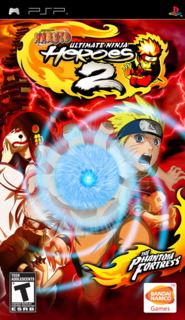It;s a great game but there are better ones out there
If you didn't play the first game, let me fill you in on some basics. Phantom Fortress is a pretty straight-forward fighting game where battles take place on two 2D planes -- one in the background of the environment and one in the foreground. So while the locales and character models are all fully 3D, Phantom Fortress is more of a 2D fighter than anything else.
Hardcore fighting game fans will find Phantom Fortress's gameplay mechanics pretty easy, though the game still demands an adequate sense of timing. All attacks are mapped to the circle button and most combos and special moves require a simple directional input along with a few button presses. Besides your standard health gauge, each character also has a Chakra gauge which governs how many Jutsu moves and Secret Techniques you can perform. On top of these mechanics, you can also use a number of items during battle and there are a few universal defense skills as well.
Although Phantom Fortress may seem like it has a great deal of depth due to the seemingly large number of gameplay elements, it's ultimately pretty simple because you really just need to worry about hitting the circle button. That's fine if you're not too adamant about having a complex fighting game, but it can make battles feel shallow at times. But again, it's still fun to flip around the screen, throw knives at your opponent and execute visually striking Secret Techniques, so I won't complain too much.
The biggest change to Phantom Fortress over the original Ultimate Ninja Heroes is the inclusion of a story, in the form of the Mugenjo Mode. In this mode, Naruto and company traverse the dark and misty corridors of a mysterious -- you guessed it -- phantom fortress, which saps the vitality out of all nearby life. Obviously having the Mugenjo appear above the Hidden Leaf Village is a problem, so Naruto intends to do away with the dark sanctuary.
The gameplay of the Mugenjo Mode harkens back to an old-school dungeon crawler, where you move your character icon from room to room, fighting battles and playing mini-games depending on what type of scroll you use to stabilize the space of the room. Essentially, you have the power to control what scenario plays out in each room. There are six different scrolls which activate varying game types, like running up the side of a tree while avoiding obstacles, following a series of button commands or answering Naruto-related questions.
Ninja power.
Although this mode runs the risk of being repetitive because there are over 100 floors to get through, this certainly adds a tremendous amount to the game's total play time, which is a great feature for Phantom Fortress. Also, completing almost any task in the game rewards you with Ninja Points, which can be spent unlocking extra features like character art and songs. This is a nice incentive to keep playing the game.
Besides Heroes Mode, which is just a series of team battles without a story, you can also take on a friend in wireless multiplayer. The cool thing about Phantom Fortress's multiplayer is the Waiting Room, which lets up to 16 people who have the game sit in a lobby and jump into matches continuously. But because it's unlikely that you'll have fifteen friends with the game, you can also send the data over game sharing. Although, like the original, you can only battle on one stage and the load times are awful, it's still a nice feature to have in case you're desperate for some multiplayer action.
But Phantom Fortress isn't all fun and games. At the end of the day, it's just a tweaked version of Ultimate Ninja Heroes, which makes you feel cheated if you shell out another 40 dollars, especially if you already played the original. I was also amazed at the fact that, as far as I can tell, there's no Training Mode. Training modes are practically a mandatory feature in fighting games, so it was startling to see it absent here.
And after spending a while with the game, I started to find the combat to be a little on the clumsier side. It's certainly not a huge issue by any stretch of the imagination, but it just didn't feel as responsive as it could have been, at least in comparison to other modern 2D fighters.
Closing Comments
If you played the original Ultimate Ninja Heroes, buying Phantom Fortress can be a real tough decision. The Mugenjo Mode does give you a lot of extra gameplay, but all the mechanics in place, along with the majority of the environments, music and other game elements, are identical to the original. Phantom Fortress is still a lot of fun (especially if you want a more accessible fighting game experience), but definitely keep the aforementioned issues in mind if you're looking to pick up a copy.

